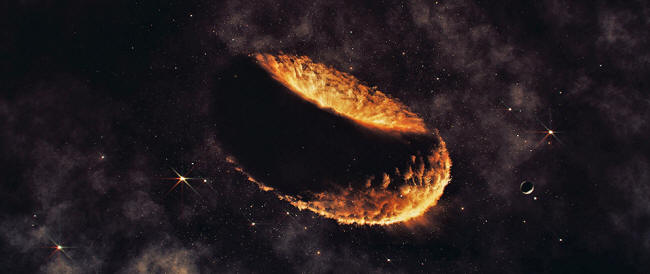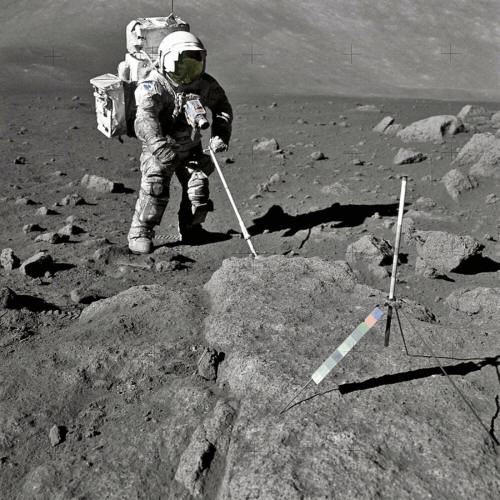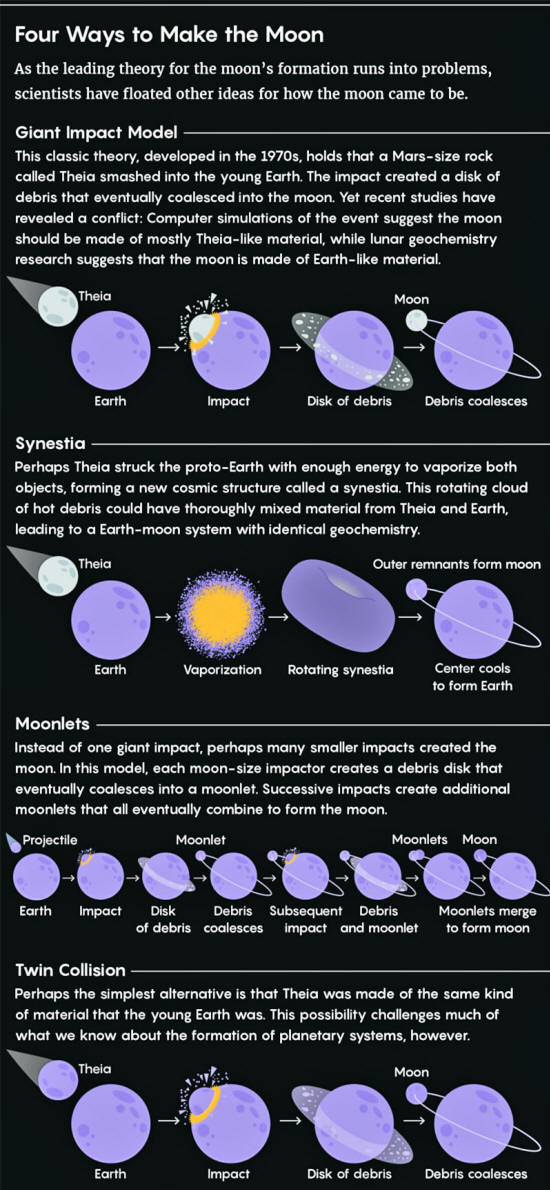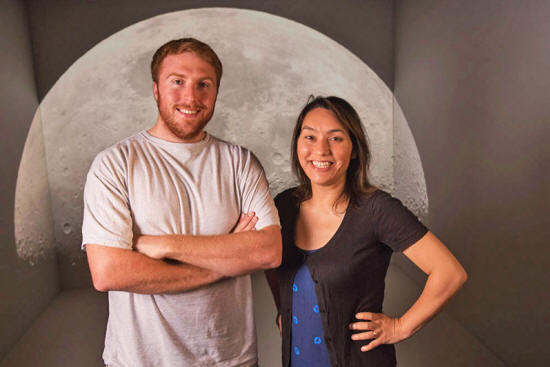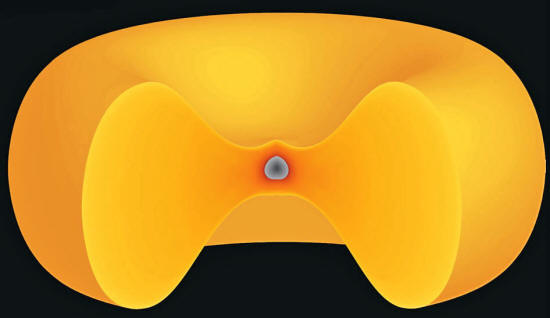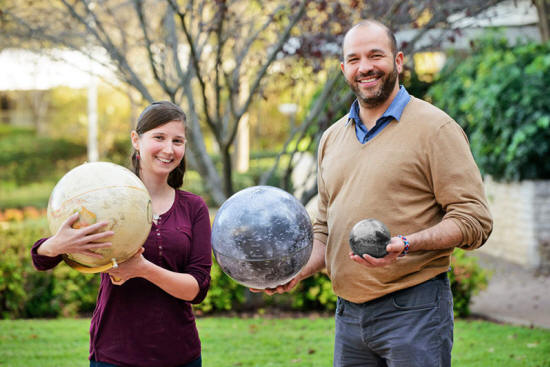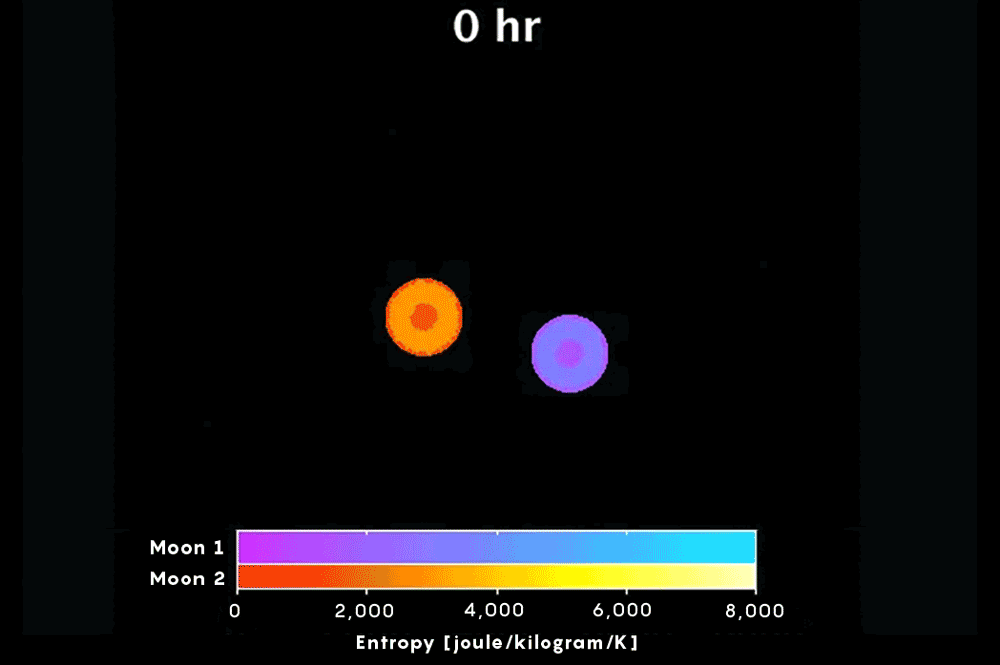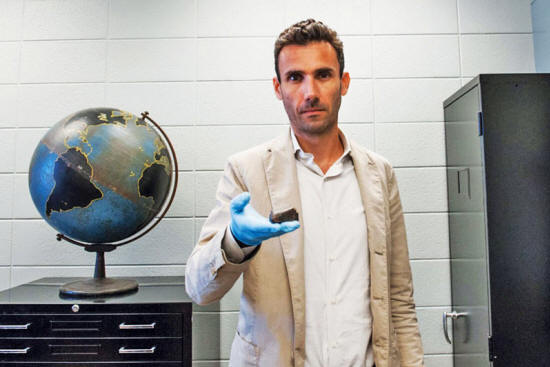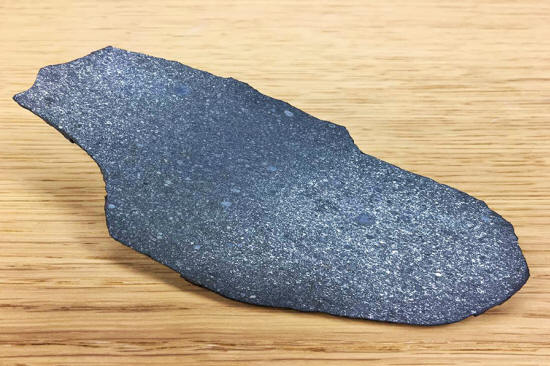|
a hypothetical object made of vaporized rock
that
might have birthed the moon.
the moon was formed after a Mars-size mass smashed the young Earth. But new evidence has cast doubt on that story, leaving researchers to dream up
new ways to get a giant rock
into orbit.
On Dec. 13, 1972, Apollo 17 astronaut Harrison Schmitt walked up to a boulder in the moon's Sea of Serenity.
Eugene Cernan bounded over to collect some samples.
The astronauts chiseled bits of the moon from the boulder.
Then, using a rake, Schmitt scraped the powdery surface, lifting a rock later named troctolite 76536 off the regolith and into history.
In this creation tale, inscribed in countless textbooks and science-museum exhibits over the past four decades, the moon was forged in a calamitous collision between an embryonic Earth and a rocky world the size of Mars.
This other world was named Theia, for the Greek goddess who gave birth to Selene, the moon. Theia clobbered Earth so hard and so fast that the worlds both melted.
Eventually, leftover
debris from Theia cooled and solidified into the silvery companion
we have today.
Harrison Schmitt, the first scientist to become an astronaut, collects lunar specimens during
the Apollo 17 mission.
But the moon does not look like Theia - or like Mars, for that matter.
Down to its atoms, it looks almost exactly like Earth. Confronted with this discrepancy, lunar researchers have sought new ideas for understanding how the moon came to be.
The most obvious solution may also be the simplest, though it creates other challenges with understanding the early solar system:
The second possibility is that the impact process thoroughly mixed everything, homogenizing disparate clumps and liquids the way pancake batter comes together.
This could have taken place in an extraordinarily high-energy impact, or a series of impacts that produced a series of moons that later combined.
The third explanation challenges what we know about planets.
It's possible that the Earth and moon we have today underwent strange metamorphoses and wild orbital dances that dramatically changed their rotations and their futures.
Lucy Reading-Ikkanda/Quanta Magazine
Bad News for
Theia
Four and a half billion years ago, the sun was surrounded by a hot, doughnut-shaped cloud of debris. Star-forged elements swirled around our newborn sun, cooling and, after eons, combining - in a process we don't fully understand - into clumps, then planetesimals, then increasingly larger planets.
These rocky bodies
violently, frequently collided and vaporized one another anew. It
was in this unspeakably brutal, billiard-ball hell-scape that the
Earth and the moon were forged.
Anything bigger or much smaller would produce a system with a much greater angular momentum than we see.
A bigger projectile
would also throw too much iron into Earth's orbit, creating a more
iron-rich moon than the one we have today.
Angular momentum is always conserved, meaning it can only be
gained or lost if something else gets involved.
They showed that lunar rocks would have originated in a lunar magma ocean, the likes of which could only be generated by a giant impact. The troctolite would have bobbed in a molten sea like an iceberg floating off Antarctica.
On the basis of these physical constraints, scientists have argued that the moon was made from the remnants of Theia.
But there is a problem. Back to the early solar system...
As rocky worlds collided and vaporized, their contents mixed, eventually settling into distinct regions. Closer to the sun, where it was hotter, lighter elements would be likelier to heat up and escape, leaving an excess of heavy isotopes (variants of elements with additional neutrons).
Farther from the sun, rocks were able to keep more of their water, and lighter isotopes persisted. Because of this, a scientist can examine an object's isotopic mix to identify where in the solar system it came from, like accented speech giving away a person's homeland.
These differences are so pronounced that they're used to classify planets and meteorite types. Mars is so chemically distinct from Earth, for instance, that its meteorites can be identified simply by measuring ratios of three different oxygen isotopes.
In 2001, using advanced mass spectrometry techniques, Swiss researchers remeasured troctolite 76536 and 30 other lunar samples.
They found that its oxygen isotopes were indistinguishable from those on Earth. Geochemists have since studied titanium, tungsten, chromium, rubidium, potassium and other obscure metals from Earth and the moon, and everything looks pretty much the same.
This is bad news for Theia.
If Mars is so obviously different from Earth, Theia - and thus, the moon - ought to be different, too. If they're the same, that means the moon must have formed from melted bits of Earth.
The Apollo rocks are then in direct conflict with what the physics insist must be true.
Sarah Stewart, a planetary scientist at the University of California, Davis,
along with her
student Simon Lock at Harvard University.
A Moon Out of
Vapor
In 2012, she and Matija Ćuk, now at the SETI Institute, proposed a new physical model for the moon's formation.
They argued that the early Earth was a whirling dervish, rotating through one day every two to three hours, when Theia collided with it. The collision would produce a disk around the Earth, much like the rings of Saturn - but it would only persist for about 24 hours.
Ultimately, this disk would cool and solidify to form the moon.
Supercomputers are not powerful enough to model this process completely, but they showed that a projectile slamming into such a fast-spinning world could shear away enough of Earth, obliterate enough of Theia and scramble enough of both to build a moon and Earth with similar isotopic ratios.
Think of smacking a wet lump of clay on a fast-spinning potter's wheel.
For the fast-spinning-Earth explanation to be right, however, something else would have to come along to slow down Earth's rotation rate to what it is now.
In their 2012 work, Stewart and Ćuk argued that under certain orbital-resonance interactions, Earth could have transferred angular momentum to the sun.
Later, Jack Wisdom of the Massachusetts Institute of Technology suggested several alternate scenarios for draining angular momentum away from the Earth-moon system.
But none of the explanations was entirely satisfactory. The 2012 models still couldn't explain the moon's orbit or the moon's chemistry, Stewart said.
Then last year, Simon Lock, a graduate student at Harvard University and Stewart's student at the time, came up with an updated model that proposes a previously unrecognized planetary structure.
In this story, every bit of Earth and Theia vaporized and formed a bloated, swollen cloud shaped like a thick bagel.
The cloud spun so quickly that it reached a point called the co-rotation limit. At that outer edge of the cloud, vaporized rock circled so fast that the cloud took on a new structure, with a fat disk circling an inner region.
Crucially, the disk was not separated from the central region the way Saturn's rings are - nor the way previous models of giant-impact moon formation were, either.
A synestia would be made of a bagel-like mass of vaporized rock
surrounding a rocky
planet.
Conditions in this structure are indescribably hellish:
The moon grew
inside this vapor, Lock said, before the vapor eventually cooled and
left in its wake the Earth-moon system.
The word means "connected structure," Stewart said.
In May, Lock and Stewart published a paper (The structure of Terrestrial Bodies - Impact Heating, Corotation Limits and Synestias) on the physics of synestias; their paper arguing for a synestia lunar origin is still in review.
They presented the work at planetary science conferences in the winter and spring and say their fellow researchers were intrigued but hardly sold on the idea.
That may be because synestias are still just an idea.
Unlike ringed planets, which are common in our solar system, and protoplanetary disks, which are common across the universe, no one has ever seen one.
Let a Dozen Moons Bloom
Among natural satellites in the solar system, Earth's moon may be most striking for its solitude.
Mercury and Venus lack natural satellites, in part because of their nearness to the sun, whose gravitational interactions would make their moons' orbits unstable.
Mars has tiny Phobos and Deimos, which some argue are captured asteroids and others argue formed from Martian impacts. And the gas giants are chockablock with moons, some rocky, some watery, some both.
In contrast to these moons, Earth's satellite also stands out for its size and the physical burden it carries.
The moon is about 1 percent the mass of Earth, while the combined mass of the outer planets' satellites is less than one-tenth of 1 percent of their parents. Even more important, the moon contains 80 percent of the angular momentum of the Earth-moon system.
That is to say, the moon is responsible for 80 percent of the motion of the system as a whole. For the outer planets, this value is less than 1 percent.
The moon may not have carried all this weight the whole time, however. The face of the moon bears witness to its lifelong bombardment; why should we assume that just one rock was responsible for carving it out of Earth?
It's possible that multiple impacts made the moon, said Raluca Rufu, a planetary scientist at the Weizmann Institute of Science in Rehovot, Israel.
In a paper (A Multiple-Impact Origin for the Moon) published last winter, she argued that Earth's moon is not the original moon. It is instead a compendium of creation by a thousand cuts - or at the very least, a dozen, according to her simulations.
Projectiles coming in from multiple angles and at multiple speeds would hit Earth and form disks, which coalesce into "moonlets," essentially crumbs that are smaller than Earth's current moon.
Interactions between moonlets of different ages cause them to merge, eventually forming the moon we know today.
Planetary scientists were receptive when her paper was published last year; Robin Canup, a lunar scientist at the Southwest Research Institute and a dean of moon-formation theories, said it was worth considering.
More testing remains, however.
Rufu is not sure whether the moonlets would have been locked in their orbital positions, similar to how Earth's moon constantly faces the same direction.
If so, she is not sure how they could have merged.
Meanwhile, others have turned to another explanation for the similarity of Earth and the moon, one that might have a very simple answer. From synestias to moonlets, new physical models - and new physics - may be moot.
It's possible that the moon looks just like Earth because Theia did, too.
Oded Aharonson, a planetary scientist at the Weizmann Institute of Technology, along with his doctoral student Raluca Rufu. Weizmann Institute of Technology (portraits); Courtesy of Raluca Rufu and Oded Aharonson (animation)
The pair devised a computer simulation that shows two moonlets coming together
to form a larger body. Courtesy of Raluca Rufu and Oded Aharonson (animation)
All the Same Stuff
The moon is not the only Earth-like thing in the solar system.
Rocks like troctolite 76536 share an oxygen isotope ratio with Earth rocks as well as a group of asteroids called enstatite chondrites.
These asteroids' oxygen isotope composition is very similar to Earth's, said Myriam Telus, a cosmochemist who studies meteorites at the Carnegie Institution in Washington, D.C.
They probably formed near where Earth did.
Some of these rocks came together to form Earth; others would have combined to form Theia. The enstatite chondrites are the detritus, remnant rocks that never combined and grew large enough to form mantles, cores and fully fledged planets.
In January, Nicolas Dauphas, a geophysicist at the University of Chicago, argued that a majority of the rocks that became Earth were enstatite-type meteorites.
He argued that anything formed in the same region would be made from them, too.
Planet-building was taking place using the same premixed materials that we now find in both the moon and Earth; they look the same because they are the same.
David Stevenson, a planetary scientist at the California Institute of Technology who has studied lunar origins since the Theia hypothesis was first presented in 1974, said he considers this paper the most important contribution to the debate in the past year, saying it addresses an issue geochemists have grappled with for decades.
Not everyone is convinced, however.
There are still questions about the isotopic ratio of elements like tungsten, Stewart points out. Tungsten-182 is a daughter of hafnium-182, so the ratio of tungsten to hafnium acts as a clock, setting the age of a particular rock.
If one rock has more tungsten-182 than another, you can safely say the tungsten-filled rock formed earlier.
But the most precise measurements available show that Earth's and moon's tungsten-halfnium ratios are the same.
Nicolas Dauphas, a geophysicist at the University of Chicago, holds a piece of an enstatite chondrite, a type of asteroid that could be made of the same material that formed Earth. Jean Lachat/ University of Chicago (Dauphas portrait)
Enstatite chondrite Jean Lachat/ University of Chicago (Dauphas portrait)
Clues on Other Worlds
Understanding the moon - our constant companion, our silvery sister, target of dreamers and explorers since time immemorial - is a worthy cause on its own.
But its origin story, and the story of rocks like troctolite 76536, may be just one chapter in a much bigger epic.
Understanding synestias might help answer that.
Lock and Stewart argue that synestias would have formed apace in the early solar system as protoplanets whacked into each other and melted. Many rocky bodies might have started out as puffy vapor halos, so figuring out how synestias evolve could help scientists figure out how the moon and other terrestrial worlds evolved.
More samples from the moon and Earth would help, too, especially from each mantle, because geochemists would have more data to sift through.
They would be able to tell whether oxygen stored deep within Earth is the same throughout, or if three common oxygen isotopes preferentially hang out in different areas.
This virtual-reality tour shows how the sun, Earth and the other planets
came to
be. for Quanta Magazine
New tweaks to solar system origin theories, which are often based on complex computer simulations, are also illuminating where planets were born and where they migrated.
Scientists increasingly suggest we can't count on Mars to tell this story, because it may have formed in a different area of the solar system than Earth, the enstatites and Theia. Stevenson said Mars should no longer be used as a barometer for rocky planets.
Ultimately, lunar scientists agree that the best answers may be found on Venus, the planet most like Earth.
It may have had a moon in its youth, and lost it; it may be very similar to Earth, or not.
Absent samples from Venus, and without laboratories that can test the unfathomable pressures and temperatures at the heart of giant impacts, lunar scientists will have to keep devising new models - and revising the moon's origin story...
|


